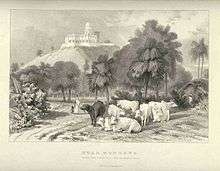John Luard
John Luard (1790–1875) was a British Army officer and author of History of the Dress of the British Soldier
Life
He was fourth son of Captain Peter John Luard of the 4th Dragoons, of Blyborough, Kirton-in-Lindsey, Lincolnshire, and his wife Louisa, daughter of Charles Dalbiac of Hungerford Park, Berkshire, born on 5 May 1790; Henry Luard the banker was his younger brother, in a family of eight sons. He served in the Royal Navy 1802–7, and on 25 May 1809 obtained a cornetcy without purchase in his father's old regiment.[1][2]
Luard served in the 4th Dragoons through the Peninsular War campaigns of 1810–14, gaining a Military General Service Medal with clasps for the battles of Albuera, Salamanca, and Toulouse.[3] Afterwards he served with the 16th Light Dragoons as lieutenant at the battle of Waterloo (medal), and as captain at Bhurtpoor in 1825-26 (Army of India Medal).[1][4]
Exchanging to the 30th Foot in 1832, Luard retired as major in 1834, and obtained a brevet lieutenant-colonelcy in 1838.[1] He took up sculpture, and chaired the Farnham School of Art.[5] He died on 24 October 1875, at The Cedars, Farnham, Surrey, his home.[1][6]
Works

Like others of his family, Luard was an artist. He published Views in India, St. Helena, and Car Nicobar (London, 1835), drawn from nature and on stone by himself, and History of the Dress of the British Soldier, published by subscription in 1852.[1]
Some of Luard's sketches were used to illustrate Wanderings of a Pilgrim in Search of the Picturesque (1850) by Fanny Parkes (Fanny Parlby), who had commissioned him as a watercolour artist. In 1851 at the Asiatic Gallery, Baker Street Bazaar, Portman Square, London, the "Grand Moving Diorama of Hindostan" comprised 60 drawings arranged by Luard.[7][8][9][10] The artists creating the diorama included Louis Haghe, who did the "figures and animals", and William Adolphus Knell the "shipping"; the panoramic setting was by Philip Phillips. Luard based the material on his own sketches, and on those of Parkes, and eight others were credited.[11]
His sketches formed the basis of the design the Ghuznee Medal, awarded for storming the fortress of Ghuznee during the First Anglo-Afghan War, although he did not serve in the war himself.[12]
Family
Luard married Elizabeth, second daughter of Colonel Richard Scott, H.E.I.C.S., with whom he had a family.[1][13] Their children included:
Notes
- Lee, Sidney, ed. (1893). . Dictionary of National Biography. 34. London: Smith, Elder & Co.
- Black, Iain S. "Luard, Henry". Oxford Dictionary of National Biography (online ed.). Oxford University Press. doi:10.1093/ref:odnb/47804. (Subscription or UK public library membership required.)
- "Military General Service Medal Roll (1793-1814)". Dix Noonan Webb. 1971. Retrieved 20 May 2018.
- "Military Army of India Medal Roll". Dix Noonan Webb. 1971. Retrieved 20 May 2018.
- "gb3094-fcol - Farnham School of Art Archive - Archives Hub". Retrieved 29 June 2016.
- Falkner, James. "Luard, John". Oxford Dictionary of National Biography (online ed.). Oxford University Press. doi:10.1093/ref:odnb/17117. (Subscription or UK public library membership required.)
- "The British Library - India Office Select Materials - Collection summary, Luard, John (1790–1875)". British Library. Retrieved 29 June 2016.
- H. L. Mallalieu (1986). The Dictionary of British Watercolour Artists up to 1920. Antique Collectors' Club. p. 218. ISBN 1-85149-025-6.
- Alison Blunt; Gillian Rose (1994). Writing Women and Space: Colonial and Postcolonial Geographies. Guilford Press. p. 42. ISBN 978-0-89862-498-4.
- The Art Journal. Virtue. 1852. p. 33.
- "Grand moving diorama of Hindostan, from Fort William, Bengal, to Gangoutri in the Himalaya". Internet Archive. London. 1853. p. 2. Retrieved 29 June 2016.
- Ghuznee Medal 1839 – designer discovered. Clive Cohen. Orders & Medals Research Society Journal, September 2016, page 189.
- "Kelly's Handbook of Distinguished People". Internet Archive. London: Kelly's Directories, Ltd. 1888. p. 692. Retrieved 29 June 2016.
- "Biography – Luard, Richard George Amherst – Volume XII (1891–1900) – Dictionary of Canadian Biography". Retrieved 29 June 2016.
- Bernard Burke (1871). A Genealogical and Heraldic History of the Landed Gentry of Great Britain & Ireland. Harrison. p. 822.
- Hughes-Hughes, Walter Oldham (1886). "The Register of Tonbridge School, from 1820 to 1886, also lists of exhibitoners, &c., previous to 1820, and of head masters and second masters". Internet Archive. Reading: I. I. Beecroft. p. 70. Retrieved 29 June 2016.
| Wikimedia Commons has media related to John Luard. |
- Attribution
![]()